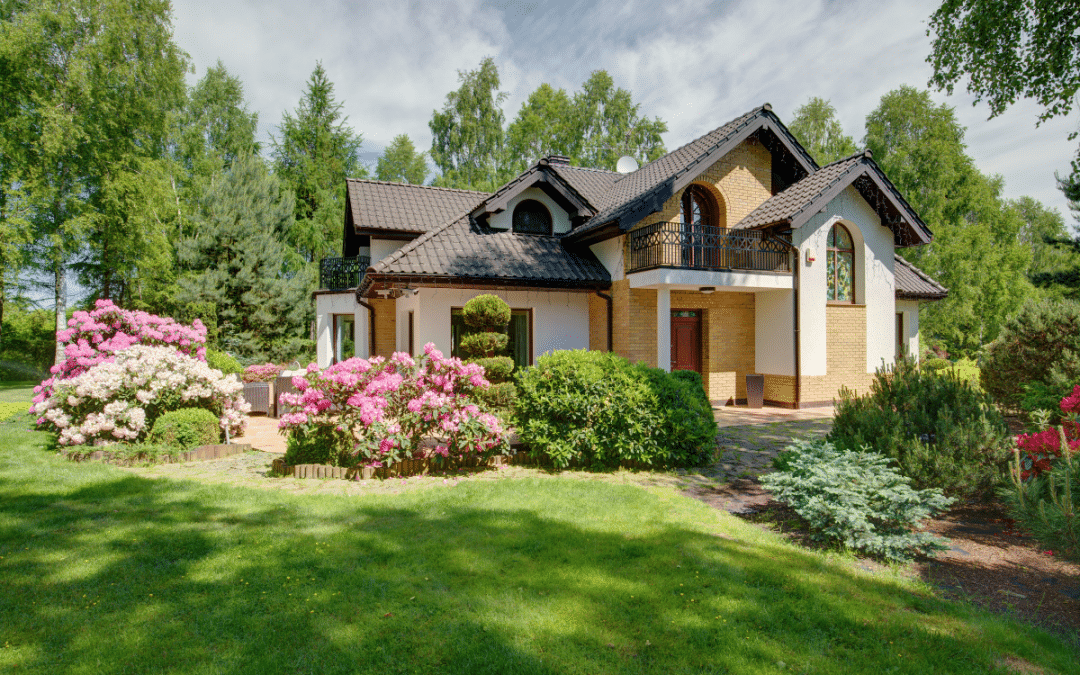In addition to numerous household tasks, homeowners need to pay attention to the grading around their foundation.
The grading, plants, and greenery surrounding a home’s foundation can impact the foundation structure, causing foundation cracks, leaks, and improper drainage around the home leading to the need for foundation repairs.
Here’s the best landscaping to plant next to your house foundation:
The Importance of Landscaping Next To House Foundation
When we think of landscaping, we often think about the aesthetics of our yard. But many new homeowners may not realize that landscaping next to the house foundation actually impacts the integrity of the structure.
The ground leading away from the house needs to be properly graded so that it slopes downward (at a slight angle) and pulls water away from the house. Blocked eavestroughs, negative grading, and the improper use of any shrub or rock fixture can cause water to pool right at the edge of the house.
Water leaking under the foundation can cause damage to your home structure. Water can encourage erosion, which over time leads to foundation failure. The soil can also harden and settle and cause cracks in the foundation.
Water seeping into a crawl space can impact its integrity as well. It’s best to steer water away from the home to limit the impact it has on your home’s foundation.
What To Put Around Foundation Of House?
When it comes to landscaping around your house, you need to be mindful of what you are putting there and how you’re doing it.
Here’s what you should put around your house foundation and how to go about it:
Best Ground Cover Next To Foundation
Mulching comes with a number of benefits, including maintaining the appropriate soil moisture. It can also draw excess water away from the foundation and reduce leaks and foundation damage.
It’s important that you don’t have dry soil or enclosed flower beds right next to your foundation. Be sure to mulch on every side of your house using mulch or natural wood chips to enrich the soil.
If you want foundation plants, consider an open flower bed with vining plants like sweet woodruff, periwinkle, creeping juniper, ivy, and liriope.
Best Landscaping Material Around Foundation
Stones and rocks, including gravel, are the best materials to put around your foundation. These rocks are not only more appealing, but they are durable, versatile, and the best way to move water away from your home.
Water drains most efficiently in gravel so you can prevent pooling. However, your underground soil composition also matters here.
Here are the best types of landscaping materials you should consider around your foundation bed:
- Concrete
- Stone
- Pressure-treated wood
- Stone, concrete, and gravel aggregate
- Brick masonry
- Sand
Putting Rock Border Around House Foundations
If you want to put a rock border around your house, you will find that your house looks better and the foundation isn’t as impacted by water seepage. Putting a rock border around house foundations makes a lot of sense as they can help heat your property and can limit excess moisture.
Here’s how to add a gravel barrier around your foundation:
- First clear the surrounding border of rocks, vegetation, plants, and weeds.
- You’ll want to dig over the ground cover at least twice to enhance the top layer soil condition.
- Rake the border area to break down lumps of soil.
- Then dig an outside border about 4 inches wide and 3 inches deep to separate the barrier from the rest of your yard.
- You’ll want to lay down a landscape fabric (also known as weed membrane or plant liner) in your prepared barrier section.
- Now you can spread gravel in the area; make sure it is evenly spread out on the liner. You’ll likely need 40kg of 20mm gravel, which will cover 1 square meter of section (based on our measurements).
- Finally, rake the gravel to smooth it out. Keep excess gravel to fill bumps or bald spots later on.
What Should You Not Plant Near A Foundation
Be mindful of your foundation planting. While the foliage may be nice, you don’t want large trees next to your house as the tree roots can create foundation problems. If you want large greenery, like trees, consider how far away they are planted from your house, the soil type, and the species.
You want to avoid the following trees around your house as they are bad for your foundation: American elm, willows, Norway maple, Silver Maple, poplars, cottonwoods, Aspens, Black Locust, and Black Alder
You can consider the following foundation planting:
- A tree-form evergreen shrub, which includes cherry laurel, ligustrum, or wax myrtle (must be 5 feet from the house).
- Plant a low-growing shrub, like holly, boxwood, yew, and juniper.
- Small ornamental trees such as star magnolia, crepe myrtle, Japanese map, redbud, and dogwood. (should be at least 2 feet from house).
For the record, keep your beautiful lawn water feature away from the foundation too!
7 Tips for Landscaping Around House Foundation
Here are 7 tips for fixing drainage problems in your yard:
1. Grade Your Landscape Properly
Your landscape grading significantly impacts how water collects around your house. The more water that collects, the more likely it is to pool around your foundation. So, grade your landscaping so that the soil is at least six inches downward for every ten horizontal feet from your foundation.
To find your slope, run a tight string with a level from the high point to the low point. You’ll know how much slope you have by measuring from the ground at your low point all the way up to the string.
You may need to improve your slope from time to time so that it is effectively drawing water down and away from your house.
2. Properly Use Foundation Planting
Large trees are nice, beautiful, and shade your house. However, too close to your home and the roots can damage your foundation and any plumbing systems that you have underground.
Be sure to plant large trees at least 5 feet away from the house. If you have trees around your home that are bad for it or too close, then you’ll want to consider removing them or moving them farther away. Additionally, they can fall over in a storm and damage your home structure. Here’s what to do if you have a large tree within 5 feet of your home:
- Install a root barrier, but consult with a professional to do it properly.
- Install an irrigation line to minimize the impact of the water collecting around the base of the trunk. This is especially useful if the soil is dry around the tree. Be sure to consult a professional.
- Have the tree removed, especially useful for small or young trees.
- You can leave it if you don’t see any signs of structural damage.
3. Clean Your Gutters
Your gutters, downspouts, and eavestroughs can impact how water is carried away from your house, so improving this system can improve your water drainage quality.
Be sure to clean your gutters regularly. Remove sticks and leaves, and check for any holes. You can also consider installing rain barrels to collect the runoff.
4. Landscape Every Side of Your House
While a simple tip, most people don’t realize that it’s important to landscape every side of your house even if you don’t see it. Landscaping shouldn’t be done for aesthetics alone. You need to landscape every side, like with a gravel barrier, for drainage reasons.
5. Mulch Flower Beds
As mentioned above, mulching your flower beds improves the soil and drainage quality. Be sure not to add a barrier to your flower beds as that can increase pooling. You can consider elevated flower beds with the proper drainage positions.
6. Build a Swale in Your Yard
A swale is a drainage ditch. You can add one to the edges of your yard, in the middle as an aesthetic (and functional) feature, or for a flower bed.
If you plant a swale,
- Note that the sides should flare out 3 to 4 times the depth (like a channel)
- Be sure to add plants along the sloping bank to improve absorption
- You can also consider lining the channel with perforated pipe, rocks, or gravel to help with absorption
- Use quick-draining soil to soak up water as it flows through
If you don’t want a full swale, you can consider a rain garden. Although not landscaping, you can also consider weeping tiles, a french drain or catch basis system which act similarly to swales.
7. Be Careful When Adding Concrete
Concrete and other rocks are great materials to plant around your foundation, but you should do so carefully. You can design these materials to direct water runoff away from your foundation.
Consider landscaping paths, patios, driveways, and sidewalks made of concrete.
Foundation Landscaping Services for Proper Drainage
Your home’s landscaping not only makes your house look better but also minimizes the amount of foundation repair you will need over time.
With the proper landscaping, you can keep your foundation healthy and your home clear of leaks.
Use these tips for proper foundation landscaping, or reach out to us at A Best Foundation Repair for more help, or if you need foundation repair due to poor landscaping around your house foundation.




